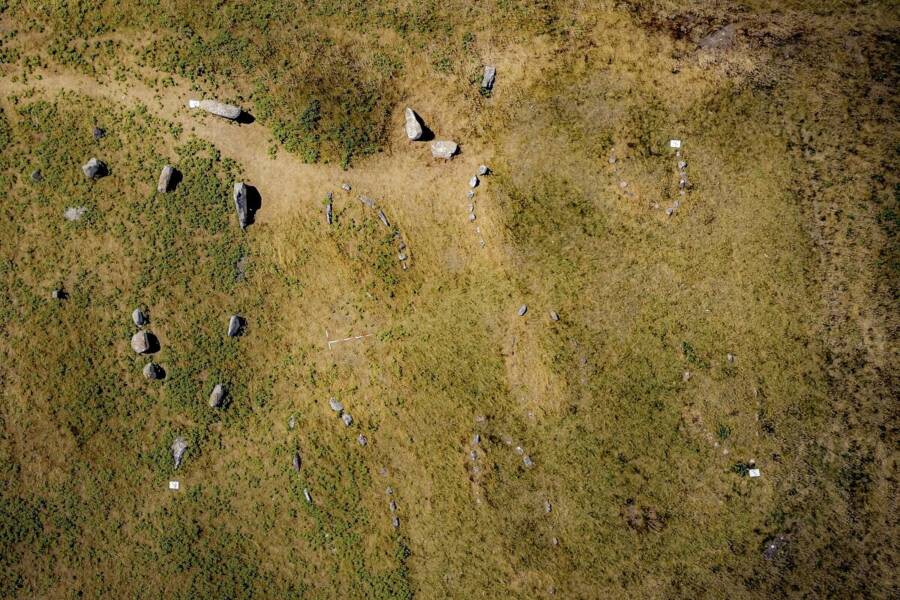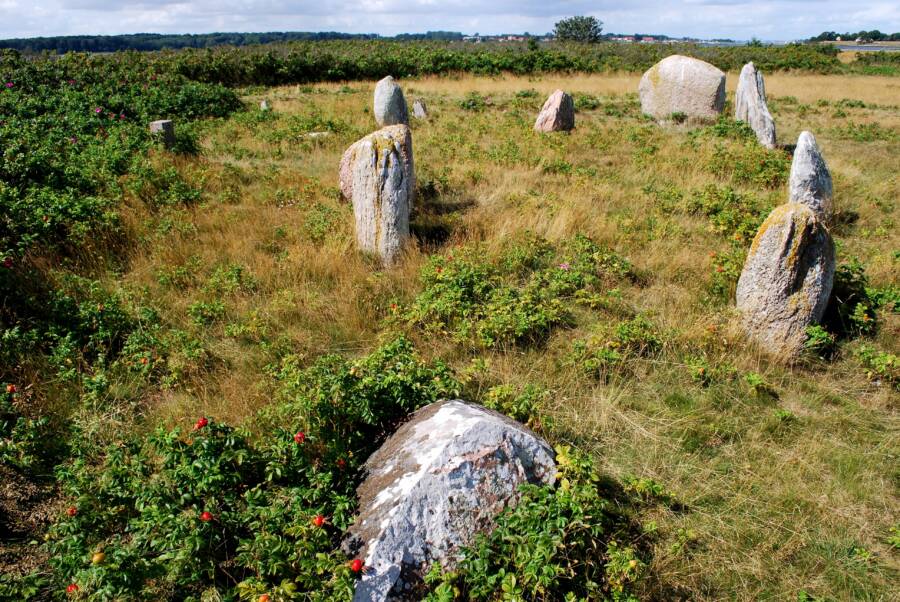The first survey of Denmark's Kalvestene Viking ship burial site in nearly 100 years used a 17th-century illustration to reveal the presence of two additional ships, bringing the total number to 12.

Flinders UniversityThe Viking-age ship burial mounds of Kalvestene, on the Danish island of Hjarnø.
In 1650, University of Copenhagen antiquarian Ole Worm made drawings of a Viking ship burial site on the small Danish island of Hjarnø. His depictions showed more than 20 ship burial mounds. Three centuries later, the National Museum of Denmark conducted the first modern survey and found only 10.
Now, using a combination of Worm’s drawings and modern technology, researchers at Flinders University in Australia have discovered two more Viking ship burials at the location, called Kalvestene. The discovery upends previous notions of the accuracy of Worm’s illustrations and provides a new understanding of the site’s significance.
“Our survey identified two new raised areas that could in fact be ship settings that align with Worm’s drawings from 1650,” said Dr. Erin Sebo, lead author of the study published in The Journal of Island and Coastal Archaeology.
“One appears to be a typical ship setting and the second remains ambiguous but it’s impossible to know without excavation and further survey.”

Wellcome LibraryOle Worm was a Danish physician, natural historian, and antiquarian who conducted the first survey of the Kalvestene Viking ship burial site in 1650.
The recent survey is the first study of the Kalvestene site since the National Museum’s research in the early 20th century. It is the first to pair Ole Worm’s drawings with on-the-ground research.
Sebo and her colleagues used several approaches to survey the site, from studying relevant medieval records and taking aerial photogrammetry to scanning the island of Hjarnø with laser imaging, detection and ranging (lidar).
The research also indicated that despite the site’s relatively small size compared to other Viking Age grave clusters, it was surprisingly well-known in medieval Scandinavia.
The name of the site, Kalvestene, literally translates to “the calf stones.” During the National Museum survey, historians dated the stones and graves to between 800 and 1050 A.D.
Scandinavian folklore is littered with references to the island. The most famous tale holds that Vikings placed the stones as a tribute to a king named Hiarni. According to legend, Hiarni became king after writing a particularly beautiful poem about the former king, whom he defeated in battle on the island.

Wikimedia CommonsThe Viking ship burials on Hjarnø are all ringed with stones that form the shape of a Viking longship.
“It seems surprising that such a small grave field would be famous and yet the existence of the site was well known in medieval Scandinavia,” Sebo said. “The island was famous probably because ships would have to sail past to reach a trading center at Horsens and artifacts…suggest the island was visited by foreign traders.”
The study also showed that the site has more in common with Swedish Viking ship burials than Danish, raising questions about links between the two cultures and this site’s specific importance.
“The site is unusual among Danish grave fields in that all the settings are ship shaped, with no surviving circle, oval, or triangle settings, mounds, or other monument types,” Sebo said.
The Viking practice of ship burials interred the dead within a wooden ship, accompanied by their material possessions. Usually covered with a large earthen mound, Viking ship burials have been discovered throughout Scandinavia as well as England, Scotland, and Ireland.
Researchers are now considering the possibility that this burial site might have been a kind of pan-Viking tribute to the Norse god Njord. Njord not only controlled the wind and weather but was symbolically recognized by his ship — the Skidbladnir. Honoring him at a crucial trading center would let seafaring Vikings rest easy knowing that their maritime journeys were safe.

Flinders UniversityThe experts used lidar scanning and aerial photogrammetry for their research of the site.
Despite the discovery of two additional ships, Jonathan Benjamin, Flinders University’s Maritime Archaeology Program Coordinator, explained that the study could not offer definitive proof that Worm’s illustrations were wholly accurate.
“Each stone was measured and drawn alongside data we acquired through low altitude photography to provide the landscape, in conjunction with sonar surveying in waters near the Viking site, to check for culturally significant material but no indications of this were located during the survey,” said Benjamin.
Ultimately, the study is an insightful look at Scandinavia’s Viking-era past and a showcase for the benefit of cross-disciplinary archaeological and textual research. Only rigorous LiDAR scanning in conjunction with medieval records and photogrammetry showed that the Kalvestene site on Hjarnø contained a significant Swedish presence — suggesting regular contact and trade between nations.
“While this study is unable to offer a conclusive understanding of the origins of Kalvestene, it demonstrates the value of combining source criticism and analysis with archaeological data to contribute towards greater understanding about the site,” said Benjamin.
After reading about the two Viking ship burials uncovered in Denmark, learn about the massive Viking ship discovered via radar in Norway. Then, take a look at 32 Viking facts that reveal one of history’s most misunderstood civilizations.





